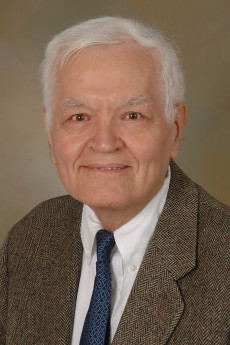Mathematician James Glimm to Give May 13 Talk on Numerical Models of Subgrid Physics
May 5, 2015

Stony Brook University Professor James Glimm will speak 10 a.m., Wednesday, May 13 in Bldg. 50 Auditorium.
Noted mathematician James Glimm will discuss “Numerical Models of Subgrid Physics” in a Computing Sciences seminar at 10 a.m. Wednesday, May 13, in the Bldg. 50 auditorium. Glimm, a distinguished professor at Stony Brook University in New York, has made fundamental contributions to nonlinear analysis, quantum field theory and computational fluid dynamics. He also heads the Computational Science Center at Brookhaven National Laboratory.
Abstract for His Talk
“Turbulence remains a major scientific and numerical obstacle for many engineering problems of practical importance; currently planned advances in computer hardware will hardly ameliorate this problem, and so the issue has to be addressed at an intellectual level. Commonly used Reynolds averaged Navier-Stokes (RANS) models, the workhorse of turbulent simulation, are data hungry due to their numerous underspecified parameters, and are hardly predictive unless supported by sufficient data. Data is generally expensive and otherwise not available, so that the more accurate Large Eddy Simulations (LES) are employed to fill this gap.
“LES are not trouble free. In this talk we will outline some of their major weaknesses, and mitigating strategies. Unreliable results with LES can usually be traced to a failure to employ LES correctly.
“In a word, the major problem with LES is the non-uniqueness of their solutions. Of course, this should be a major concern when the goal is predictive science. LES has fewer parameters than RANS and a simpler formulation. Even with this fact, the key weakness of LES lies in its parameters, both their identification and their realization in a numerical algorithm.
“In this talk, we first identify at an intuitive level the origins of LES nonuniqueness. We find that the missing ingredient is the subgrid physics of fluid transport embedded in the numerical algorithm. In part the subgrid fluid transport is addressed by the addition of "models" to the fluid equations, and with a recipe for the choice of dynamic (space-time dependent) model coefficients.
“For reasons of numerical stability, (turbulent) diffusion can be added to the equations in this manner, but it cannot be subtracted. Thus we also propose a Front Tracking algorithm to control excesses of numerical diffusion. The use of this algorithm is called for in Eulerian algorithms applied to problems with a Schmidt or Prandtl number in excess of 0.3.
“Finally, we address issues of technology transfer, with an API (called FTI) for front tracking, to allow its ready adaption into other physics packages. The interface and operations on it are supported with high order accuracy. Future versions of this API will support fully conservative tracking.”
More about Jim Glimm
Glimm is a member of the National Academy of Science and Academia Sinica and is a recipient of the National Medal of Science (2002). He is the recipient of the American Mathematical Society’s Leroy P. Steele Prize (1993) and the American Physical Society’s Heineman Prize (1980). He served as president of the American Mathematical Society from 2007-08.
Add This Even to Your Google Calendar
Remote Access Instructions for Audio & Web Conference
To begin AUDIO conference:
1. Dial Toll-Free Number: 866-740-1260 (U.S. & Canada)
2. International participants dial: Toll Number: 303-248-0285, or Toll-Free: http://www.readytalk.com/intl
3. Enter 7-digit access code: 4958130, followed by “#”
4. Place your phone on "Mute"
To begin WEB conference:
1. Go to:http://www.readytalk.com
2. Enter your access code: 4958130 under “PARTICIPANT-Join A Conference”
About Computing Sciences at Berkeley Lab
High performance computing plays a critical role in scientific discovery. Researchers increasingly rely on advances in computer science, mathematics, computational science, data science, and large-scale computing and networking to increase our understanding of ourselves, our planet, and our universe. Berkeley Lab’s Computing Sciences Area researches, develops, and deploys new foundations, tools, and technologies to meet these needs and to advance research across a broad range of scientific disciplines.







 Instagram
Instagram YouTube
YouTube